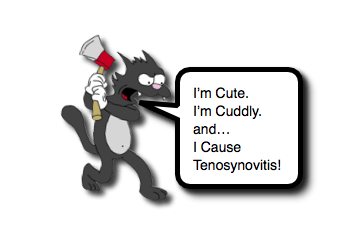Flexor Tenosynovitis
 The human hand is amazing. Amazing in its power, its structure, … and in its ability to become injured. Children, who are less nimble, get their hands into trouble frequently. Sometimes that injury can be relatively simple (ex, subungal hematoma), while other times it may be a little bit more challenging (ex, metacarpal fractures). Additionally, infectious processes need to be contemplated (ex, Herpetic Whitlow, Blistering Dactylitis). Let’s review another condition that involves both infection and injury – Pyogenic Flexor Tenosynovitis.
The human hand is amazing. Amazing in its power, its structure, … and in its ability to become injured. Children, who are less nimble, get their hands into trouble frequently. Sometimes that injury can be relatively simple (ex, subungal hematoma), while other times it may be a little bit more challenging (ex, metacarpal fractures). Additionally, infectious processes need to be contemplated (ex, Herpetic Whitlow, Blistering Dactylitis). Let’s review another condition that involves both infection and injury – Pyogenic Flexor Tenosynovitis.
Flexor Tenosynovitis: Basics
- Pyogenic flexor tenosynovitis (PFT) = infection of the flexor tendon sheath
- The flexor tendon sheath provides nutrition, optimal gliding, and restraint for the extrinsic tendons to the digits.
- The sheath has two layers that form a sealed synovial space.
- Connections between one synovial space and another can be present, or even develop during an infection. [Hyatt, 2017]
- PFT can lead to significant sequelae:
- Finger stiffness
- Tendon necrosis and rupture
- Hand dysfunction
- Amputation
- Systemic infection
- ~75% of cases are associated with antecedent injury. [Brusalis, 2017]
- Penetrating injuries are the most common (ex, cat scratch/bite). [Hyatt, 2017]
- Patients often present 2-5 days after an injury. [Hyatt, 2017]
- PFT is a clinical diagnosis!!
- Kanavel’s Signs:
- Tenderness over the tendon sheath
- Most common finding in kids with PFT. [Brusalis, 2017]
- The greatest tenderness is generally over the proximal end of the sheath, just over the MCP joint. [Hyatt, 2017]
- Pain with passive extension of the digit
- 2nd most common finding in kids.
- These first 2 signs are most useful. [Brusalis, 2017]
- Fusiform swelling of the digit
- Flexed position of the digit
- Tenderness over the tendon sheath
- PFT can be present without Kanavel’s signs. [Hyatt, 2017; Brusalis, 2017]
- These signs are less reliable in the thumb and pinky.
- They are also less reliable in children.
- Kanavel’s Signs:
- Distinguishing from other clinical entities can be challenging. [Brusalis, 2017]
- Labs may be requested (like my favorite ESR, CRP, WBC).
- Labs can be normal in more than 50% of cases. [Brusalis, 2017]
- Ultrasound has been used to help define PFT. [Cohen, 2015]
Flexor Tenosynovitis: DDx
- Cellulitis – not restricted to one digit, pain with flexion and extension
- Paronychia – lateral nail fold infection
- Felon – infection in distal finger pad pulp
- Deep space infection – diffuse edema, palpable abscess
- Herpetic Whitlow – vesicles present
- Septic arthritis – pain with flexion or extension, typically from a dorsal injury
[Hyatt, 2017]
Flexor Tenosynovitis: The Bugs
- Strep and Staph (as expected) are the most common organisms involved.
- MRSA is often (29-38%) encountered in children. [Brusalis, 2017]
- ~20% of patients will have multiple organisms involved. [Brusalis, 2017]
- Anaerobic organisms are also encountered. [Harness, 2005]
Flexor Tenosynovitis: Treatment
- Orthopaedic/Hand Surgery consultation for irrigation, drainage, and debridement.
- Multiple approaches have been described. [Hyatt, 2017]
- Adults may benefit from continuous irrigation, although debated.
- Children can be adequately managed without irrigation. [Brusalis, 2017]
- IV antibiotics
- Use a regimen that covers for MRSA. (ex, vancomycin) [Hyatt, 2017; Brusalis, 2017]
- Broad spectrum antibiotics are also recommended given potential for polymicrobial infections. (ex, pip/tazo). [Hyatt, 2017; Brusalis, 2017; Harness, 2005]
- Discuss timing of antibiotics with surgeon, as she/he may prefer collecting intra-operative cultures prior to antibiotics.
- Some, very mild cases, may be treated with IV antibiotics alone, but decision should be that of consultant.
Moral of the Morsel:
- Hand infections are bad! They are not all created equal though. Be vigilant for Pyogenic Flexor Tenosynovitis!
- Know your Kanavel signs, but consider augmenting your exam with U/S!
- Consult early… and ask whether you can start antibiotics early!
References
Hyatt BT1, Bagg MR2. Flexor Tenosynovitis. Orthop Clin North Am. 2017 Apr;48(2):217-227. PMID: 28336044. [PubMed] [Read by QxMD]
Brusalis CM1, Thibaudeau S2, Carrigan RB1, Lin IC2, Chang B2, Shah AS3. Clinical Characteristics of Pyogenic Flexor Tenosynovitis in Pediatric Patients. J Hand Surg Am. 2017 May;42(5):388. PMID: 28341068. [PubMed] [Read by QxMD]
Cohen SG1, Beck SC. Point-of-Care Ultrasound in the Evaluation of Pyogenic Flexor Tenosynovitis. Pediatr Emerg Care. 2015 Nov;31(11):805-7. PMID: 26535504. [PubMed] [Read by QxMD]
Harness N1, Blazar PE. Causative microorganisms in surgically treated pediatric hand infections. J Hand Surg Am. 2005 Nov;30(6):1294-7. PMID: 16344191. [PubMed] [Read by QxMD]


[…] Peds EM Morsels on pediatric cases […]
Generally, early infection should be managed with tendon sheath irrigation and drainage, with or without debridement.